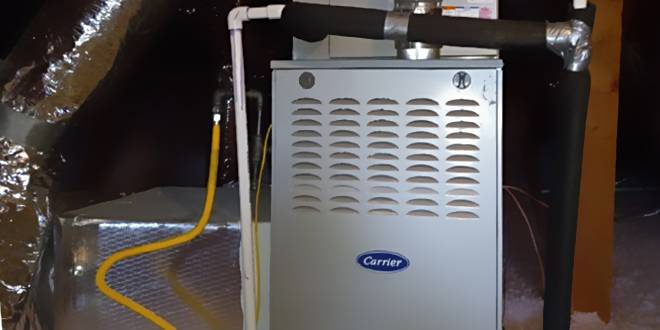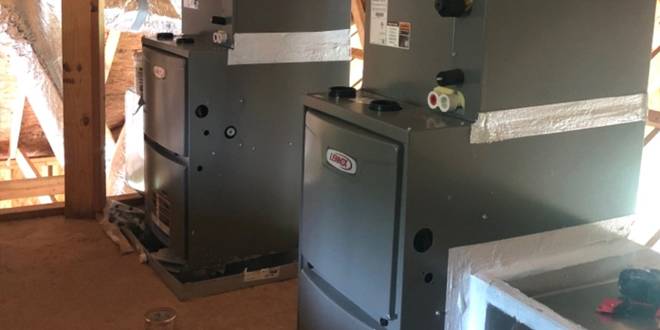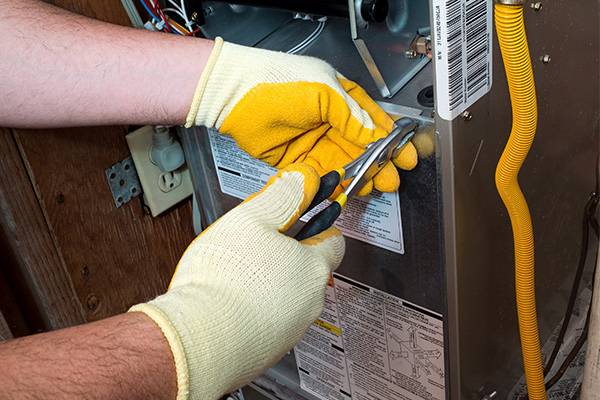
Understanding the Common Problems and the Importance of Timely Repairs
In the heart of Tulsa, where the weather can swing from scorching summers to chilling winters, having a functional furnace is not just a matter of comfort but a necessity. Homeowners often face the daunting task of dealing with furnace issues, some of which can be resolved with a bit of DIY knowledge, while others require professional intervention.
In this guide, we aim to arm you with the essential information needed to identify common electric and natural gas furnace problems, understand their potential causes, and determine the best course of action. Whether you’re a seasoned DIY enthusiast or a first-time homeowner, this guide is tailored to help you navigate the complexities of furnace repairs in Tulsa, OK.
We’ll start by exploring basic troubleshooting steps that can be safely performed without professional help. Next, we delve into common furnace problems specific to the Tulsa area and their practical solutions. We also emphasize the importance of knowing when to call a professional, as some issues can be beyond the scope of DIY and require expert handling to ensure safety and efficiency. Finally, we’ll discuss preventative maintenance, a critical aspect of keeping your heating system in top condition and avoiding future breakdowns.
With this guide, you’ll gain the confidence to tackle furnace issues head-on and ensure your home remains warm and cozy, irrespective of the weather outside. Let’s dive into the world of furnace troubleshooting and repair, tailored specifically for the residents of Tulsa, OK.
How to Fix a Furnace: Basic Steps Homeowners in Tulsa Can Take Before Calling a Professional

When your furnace malfunctions, it can be a source of immediate stress, especially during Tulsa’s colder months. Before rushing to call a professional, there are several troubleshooting steps you can take. These steps not only empower you as a homeowner but can also save you time and money. Here’s a guide to basic DIY furnace troubleshooting:
- Check the Thermostat: The first and simplest step is to ensure your thermostat is set correctly. Check if it’s on the right setting (‘heat’ during winters) and if the desired temperature is set appropriately.
- Inspect the Furnace Filter: A clogged air filter can impede airflow and affect furnace performance. Check your filter monthly and replace it if it’s dirty. This is a simple yet effective way to prevent a host of furnace issues.
- Ensure the Furnace Power is On: Sometimes, the issue might be as simple as the furnace or its switch being accidentally turned off. Check the power supply, and ensure the furnace switch (usually located on or near the furnace) is on.
- Look at the Circuit Breaker: If the furnace isn’t receiving power, the circuit breaker might have tripped. Locate your home’s electrical panel and check if the furnace’s breaker is in the correct position.
- Examine the Furnace Flame: The flame should be a steady blue. If it’s yellow, it could indicate a ventilation problem. However, dealing with gas or flame issues is risky and is best left to professionals.
- Check Vents and Registers: Ensure all vents and registers in your home are open and unobstructed. Blocked vents can disrupt proper airflow and strain the furnace.
- Listen for Unusual Noises: Sounds like banging, whistling, or grinding can indicate mechanical problems. While identifying the noise can be helpful, repairing mechanical issues typically requires a professional.
- Try a System Reset: If your furnace isn’t responding, try turning it off at the power switch, waiting a few minutes, and then turning it back on. Sometimes, a simple reset can resolve minor issues.
If these steps don’t resolve the problem, or if you’re uncomfortable performing any of them, it’s time to call a professional. Regular maintenance by a qualified technician is also recommended to prevent future issues and ensure your furnace operates safely and efficiently.
Common Furnace Problems and Solutions: A Guide to Identifying and Resolving Frequent Issues

Furnace problems can range from simple fixes to complex issues that require professional expertise. For Tulsa homeowners, understanding these common problems and their potential solutions can be immensely helpful. Here’s a breakdown of frequent furnace issues and how to address them:
- Furnace Not Blowing Hot Air: If your furnace isn’t providing heated air, check if the thermostat is set correctly and the filter is clean. If these are fine, the issue could be with the gas supply or the pilot light.
- Pilot Light Issues: Older furnaces have a pilot light, which can go out due to drafts or clogs. Relighting the pilot may resolve the issue, but if it goes out frequently, it’s best to call a professional.
- Furnace Making Strange Noises: Rumbling, squeaking, or banging noises often indicate mechanical problems, like a loose belt or an issue with the ignition system. While you can identify the noise, fixing mechanical issues typically requires technical expertise.
- Frequent Cycling: If your furnace turns on and off more frequently than normal, it might be due to a bad thermostat setting, a clogged filter, or improper airflow. Check these components first.
- Blower Runs Continuously: This could be due to a problem with the limit switch, which might need professional adjustment or replacement.
- Thermostat Malfunctions: Sometimes, the issue lies with the thermostat and not the furnace. Check if the thermostat is functioning correctly and replace batteries if it’s battery-operated.
- Dirty Filters: One of the most common issues leading to a variety of problems is a dirty filter. Regularly replacing the filter can prevent many issues and improve efficiency.
- Heating Inconsistency: If some rooms are warmer than others, it could be due to poor insulation, duct problems, or issues with the furnace’s capacity. While you can check for obvious duct blockages, other issues often require a professional assessment of the heat exchanger or the gas valve.
- Carbon Monoxide Leaks: If you suspect a carbon monoxide leak (indicated by a yellow furnace flame instead of blue, streaks of soot around the furnace, excess moisture on windows/walls, or a rusting flue pipe), evacuate immediately and call a professional. Carbon monoxide leaks are dangerous and need urgent attention.
For many of these issues, particularly those involving gas, electrical components, or complex mechanical systems, it’s advisable to seek help from a qualified HVAC technician. Regular maintenance checks can also prevent these problems from arising and ensure your furnace runs safely and efficiently.
When to Call a Professional in Tulsa: Knowing the Limits of DIY and When to Seek Expert Help
While many furnace issues can be addressed with DIY methods, there are certain situations where calling a professional is not just recommended but necessary. For Tulsa residents, understanding these scenarios can prevent further damage to their furnaces and ensure their safety. Here are instances when you should consider professional help:
- Gas Leaks or Smell of Gas: If you smell gas or suspect a leak, evacuate the area immediately and contact emergency services or a professional. Gas leaks are serious and pose significant risks.
- Persistent Issues Despite DIY Fixes: If you’ve attempted troubleshooting but the problem persists, it’s time to call in a professional. This indicates a deeper issue that requires expert furnace repair service.
- Complex Mechanical Problems: Issues like a faulty furnace door, flame sensor, broken belts, or problems with the furnace blower motor require technical knowledge and specialized tools. These are best handled by trained technicians.
- Electrical Issues: Any problems involving the furnace’s electrical system should be addressed by a professional. Electrical work can be dangerous and requires expertise.
- Installation and Major Repairs: Installing a new furnace or conducting major repairs are tasks that require professional skills and adherence to safety codes and regulations.
- Regular Maintenance and Inspections: Regular professional maintenance can extend the life of your furnace, improve efficiency, and prevent future problems. An annual inspection by a qualified technician is recommended.
- Warranty Concerns: If your furnace is under warranty, DIY repairs might void the warranty. Always check your warranty terms and consider professional service to keep it valid.
- Safety Concerns: If you’re unsure about any aspect of furnace repair or if there’s a potential risk involved, it’s always safer to rely on a professional. Safety should always be your top priority.
Remember, while DIY furnace repairs can be gratifying and cost-effective, the safety and well-being of your household should never be compromised. Professionals in Tulsa have the expertise, tools, and knowledge to safely and effectively address your furnace issues.
Preventative Maintenance for Long-Term Furnace Health: Tips for Tulsa Residents
Maintaining the health of your furnace is key to ensuring a warm, safe home environment, especially during Tulsa’s colder months. Preventative maintenance not only prolongs the life of your furnace but also enhances efficiency and safety. Here are some essential maintenance tips:
- Regular Filter Changes: Change your furnace filter every 30 to 90 days, depending on usage and type of filter. A clean filter improves airflow and efficiency and prevents dust and debris from entering the furnace.
- Annual Professional Inspections: Schedule a yearly inspection with a qualified HVAC technician. They can identify and address issues that may not be visible or apparent to the untrained eye.
- Keep the Area Around Your Furnace Clear: Ensure there’s no storage or clutter around the furnace. This reduces fire risks and allows easy access for maintenance and repair.
- Test Your Carbon Monoxide Detectors: Regularly test and replace the batteries in your carbon monoxide detectors. This is crucial for detecting dangerous leaks from your furnace.
- Check Your Thermostat: Regularly ensure that your thermostat is working correctly and reflects the actual temperature of your home. A malfunctioning thermostat can lead to overworking your furnace.
- Inspect Vents and Ducts: Make sure all vents and ducts are clear of blockages. Blocked vents can cause the furnace to work harder, decreasing efficiency and lifespan.
- Lubricate Moving Parts: If your furnace has any accessible moving parts, they may need occasional lubrication to operate smoothly. Check your owner’s manual for guidance, or consult a professional.
- Be Attentive to Sounds and Smells: Unusual noises or smells can be early indicators of problems. Addressing these early can prevent more significant issues down the line.
- Consider Upgrading Older Systems: If your furnace is old and frequently needs repairs, it may be more cost-effective to replace it with a newer, more efficient model.
By following these preventative maintenance tips, Tulsa residents can ensure their furnace remains reliable, efficient, and safe year-round. Remember, regular maintenance not only saves you money in the long run but also gives you peace of mind.
Stay Warm with Cartwright Heat & Air
Ready to ensure your furnace is in top shape? Contact Cartwright Heat & Air today! Our expert team in Tulsa, OK, is here to help with all your heating needs. From maintenance to repairs, we provide solutions that keep you cozy. Call us for exceptional service and peace of mind. Let’s keep your home warm together!








